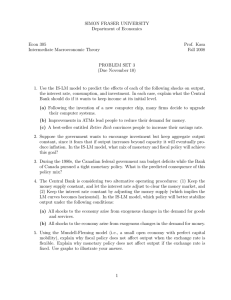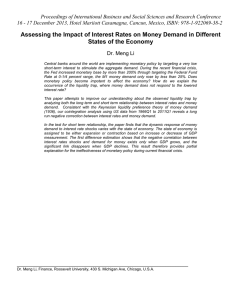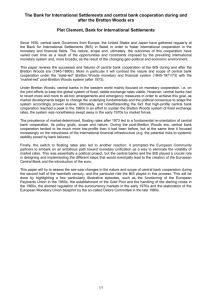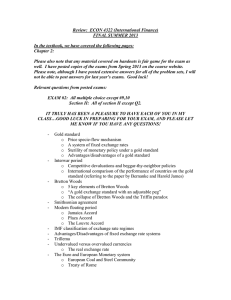SIMON FRASER UNIVERSITY Department of Economics Econ 345 Prof. Kasa
advertisement
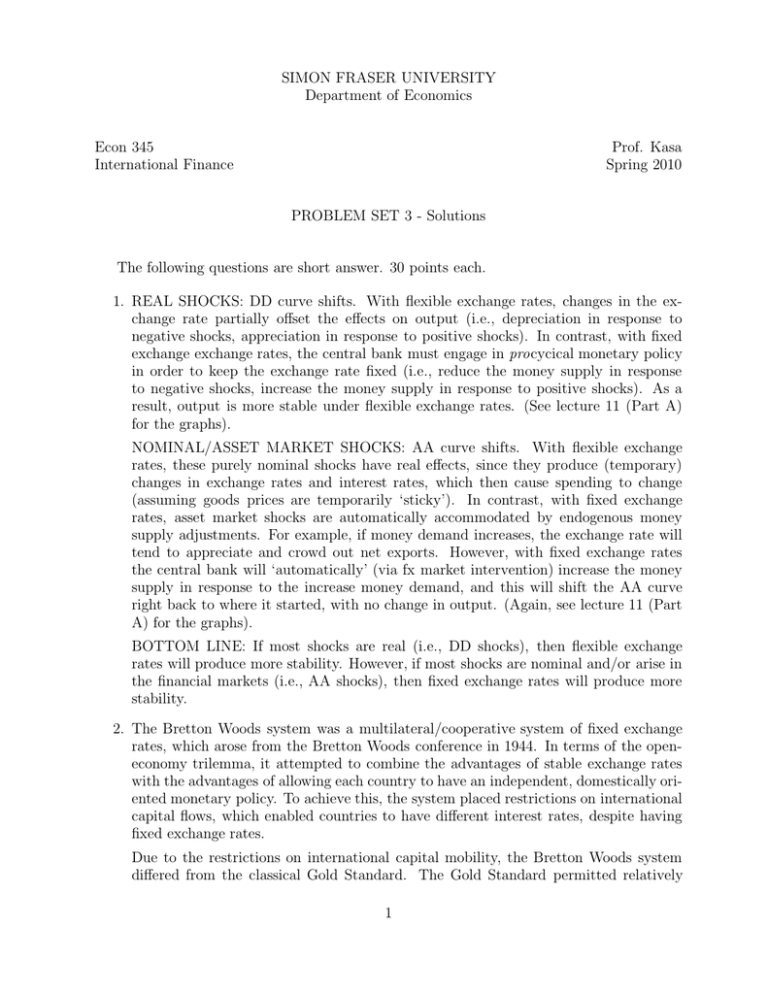
SIMON FRASER UNIVERSITY Department of Economics Econ 345 International Finance Prof. Kasa Spring 2010 PROBLEM SET 3 - Solutions The following questions are short answer. 30 points each. 1. REAL SHOCKS: DD curve shifts. With flexible exchange rates, changes in the exchange rate partially offset the effects on output (i.e., depreciation in response to negative shocks, appreciation in response to positive shocks). In contrast, with fixed exchange exchange rates, the central bank must engage in procycical monetary policy in order to keep the exchange rate fixed (i.e., reduce the money supply in response to negative shocks, increase the money supply in response to positive shocks). As a result, output is more stable under flexible exchange rates. (See lecture 11 (Part A) for the graphs). NOMINAL/ASSET MARKET SHOCKS: AA curve shifts. With flexible exchange rates, these purely nominal shocks have real effects, since they produce (temporary) changes in exchange rates and interest rates, which then cause spending to change (assuming goods prices are temporarily ‘sticky’). In contrast, with fixed exchange rates, asset market shocks are automatically accommodated by endogenous money supply adjustments. For example, if money demand increases, the exchange rate will tend to appreciate and crowd out net exports. However, with fixed exchange rates the central bank will ‘automatically’ (via fx market intervention) increase the money supply in response to the increase money demand, and this will shift the AA curve right back to where it started, with no change in output. (Again, see lecture 11 (Part A) for the graphs). BOTTOM LINE: If most shocks are real (i.e., DD shocks), then flexible exchange rates will produce more stability. However, if most shocks are nominal and/or arise in the financial markets (i.e., AA shocks), then fixed exchange rates will produce more stability. 2. The Bretton Woods system was a multilateral/cooperative system of fixed exchange rates, which arose from the Bretton Woods conference in 1944. In terms of the openeconomy trilemma, it attempted to combine the advantages of stable exchange rates with the advantages of allowing each country to have an independent, domestically oriented monetary policy. To achieve this, the system placed restrictions on international capital flows, which enabled countries to have different interest rates, despite having fixed exchange rates. Due to the restrictions on international capital mobility, the Bretton Woods system differed from the classical Gold Standard. The Gold Standard permitted relatively 1 free capital flows, but at the cost of requiring each country to give up control of its own monetary policy. Another important difference from the Gold Standard was that Bretton Woods was highly asymmetric. Rather than having each country peg its currency to gold, as in the Gold Standard, Bretton Woods only required the U.S. to peg to gold, and then all other countries were supposed to peg their currencies to the dollar. This had the advantage of increasing the liquidity of the international financial system. However, it gave a lot of power to the U.S., since the U.S. effectively got to dictate the world’s monetary policy (since foreign central banks were obliged to accept U.S. dollars as reserves). Eventually, by the late 1960s, foreign economies (particularly France and Germany) were becoming increasingly dissatisfied with the system. They resented the ‘exhorbitant priviledge’ that Bretton Woods conferred on the U.S., and they also began to lose confidence in the ability of the U.S. to maintain the value of the dollar against gold. Fearing a potential capital loss, foreign central banks began to convert their dollar reserves into gold. With gold stocks running low, and unwilling to change the course of its own monetary policy, the U.S. eventually (in 1971) ‘closed the gold window’, effectively ending the Bretton Woods system. LESSON: Multilateral fixed exchange rate systems require a lot of cooperation among the participants. If participants cannot agree on a mutually acceptable monetary policy, the system will likely fail, especially these days, when capital controls are so difficult to enforce. 3. FLEXIBLE EXCHANGE RATES: Monetary policy tends to be transmitted negatively, since it operates via changes in the exchange rate and net exports. In contrast, fiscal policy tends to be transmitted positively. This is because the expanding economy will tend to suffer a reduction in net exports, which provides stimulus abroad. (See lecture 11, Part A). FIXED EXCHANGE RATES: Now monetary policy tends to be transmitted positively. This will be the case if either the expanding economy is ‘large’ (in the sense that its money supply is a significant share of the world’s money supply), or if both countries bear some of the responsibility of intervening to sustain the system. When this is the case, one country’s monetary expansion will cause the world interest rate to to fall, and this causes spending and output to expand in both economies. In contrast, under the same conditions, fiscal policy will tend to be transmitted negatively. The economy experiencing the fiscal expansion will experience a monetary expansion, while the other economy will experience a monetary contraction. The monetary expansion reinforces the positive output effects in the expanding economy. However, in the other country, where no fiscal expansion is taking place, the required monetary contraction leads to a decline in output. As a result, output moves in opposite directions, and the transmission is ‘negative’. CAVEAT: These output effects will produce offsetting DD curve shifts, due to effects of foreign output on domestic net exports. 2
